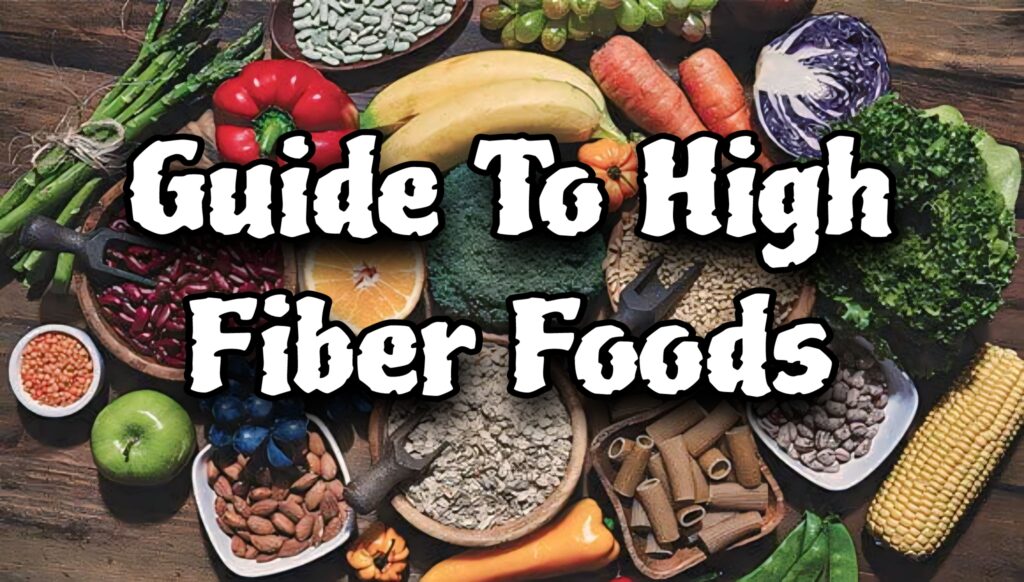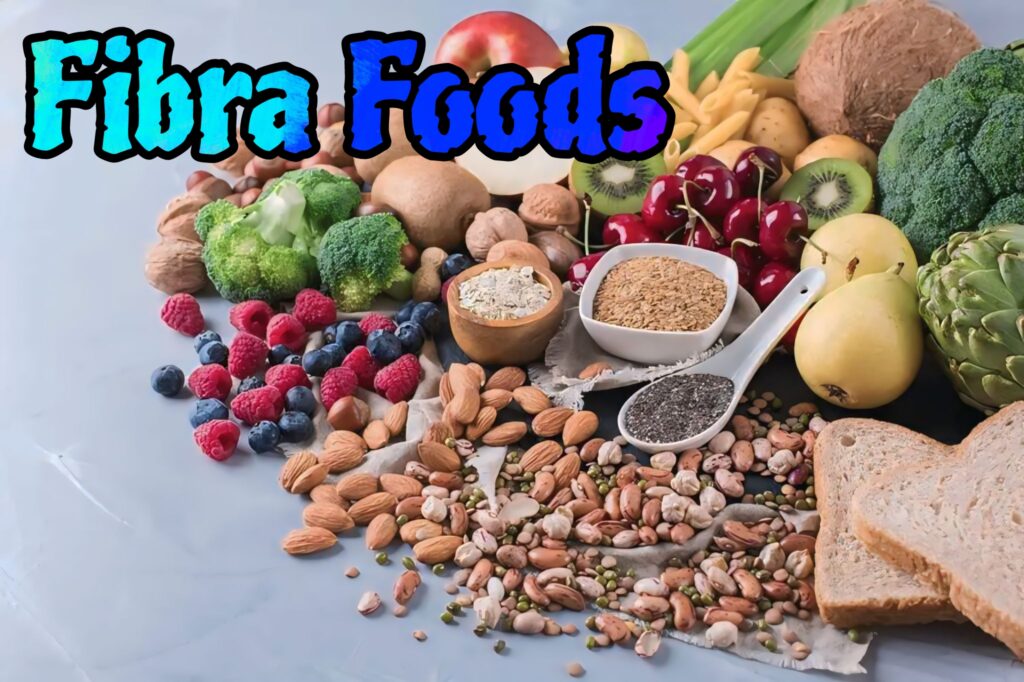
Guide to High-Fibra Foods for a Healthy Diet"
Fiber is a critical aspect of a balanced diet, imparting several fitness benefits. Yet, it is regularly neglected in the whirlwind of protein-packed and occasional-carb weight-reduction plan traits. Incorporating excessive-fiber foods into your diet is important for retaining digestive health, regulating blood sugar ranges, or even reducing the threat of chronic diseases.
This comprehensive guide will explore the kinds of nutritional fiber, their blessings, and plenty of high-fiber food alternatives to include in your daily diet.
What Is Dietary Fiber?
Dietary fiber is a plant-based carb that the packaging can’t process. Unlike other carbs, fiber passes through the stomach-related contraption pretty flawlessly, adding to various wellness favors.
Types of Dietary Fiber
- Dissolvable Fiber: Solvent fiber breaks down in water, framing a gel-like substance inside the digestive system. It permits the decline of LDLof LDL cholesterol and settles glucose levels.
- Examples: Oats, apples, and lentils.
- Insoluble Fiber: Insoluble fiber never breaks up again in water. It gives mass to stools and helps in ordinary solid discharges.
- Examples: Whole grains, nuts, and greens.
Why Is Fiber Important?
Fiber plays an essential role in normal health. Here’s why you should prioritize it on your food plan:
1. Promotes Digestive Health
Fiber helps forestall clogging by adding mass to the stool. It moreover advances the growth of sound stomach microscopic organisms.
2. Keeps up with Solid Weight
High-fiber feasts are filling, bringing down starvation aches and halting indulging.
3. Controls Glucose Levels
Soluble fiber slows sugar absorption, stopping spikes in blood sugar tiers.
4. Brings down Cholesterol
Dissolvable fiber ties with cholesterol particles, assisting with putting them off from the body.
5. Decreases the Gamble of Constant Infections
An inordinate fiber weight-decrease plan is connected with a lower opportunity of coronary heart disease, diabetes, and certain tumors.
How Much Fiber Do You Want?
The recommended everyday fiber consumption varies via age and gender:
- Women: 25 grams
- Men: 38 grams
- Older Adults: 21-30 grams
Sadly, the vast majority gobble up undeniably, which is not precisely the supported sum. Adding extreme fiber dinners to your food can assist with overcoming this issue.
High-Fiber Food varieties to Remember for Your Eating regimen
Entire Grains
All grains contain all grain components, making them wealthy in fiber.
- Oats: A morning meal staple brimming with solvent fiber, alluded to as beta-glucan, permits a decrease in LDL cholesterol.
- Quinoa: A gluten-free grain well off in fiber and protein.
- Earthy colored Rice: A fiber-well-off choice to white rice.
2. Legumes
Vegetables are a massive inventory of each solvent and insoluble fiber.
- Chickpeas: Incredible for plates of mixed greens or making hummus.
- Dark Beans: Ideal for soups, stews, and burritos.
3. Fruits
Organic products are not only delicious but also high in fiber.
- Apples: Contain gelatin, a type of solvent fiber.
- Berries: Raspberries and blackberries are predominantly over the top in fiber.
4. Vegetables
Vegetables are fiber-rich and add urgent nutrients to your get-healthy plan.
- Broccoli: A cruciferous vegetable high in both fiber and supplements.
- Carrots: Simple to nibble on and stacked with fiber.
5. Nuts and Seeds
These small foods have a fiber punch.
- Chia Seeds: Only one ounce consolidates 10 grams of fiber.
- Almonds: A small bunch makes for a very decent tidbit.
- Flaxseeds: Ideal for sprinkling over oats or yogurt.
Ways to Expand Fiber Admission
1. Start Slowly
Abruptly growing fiber can motivate bloating or fuel. Gradually introduce excessive-fiber meals into your weight loss program.
2. Stay Hydrated
Fiber absorbs water, so ingesting masses of fluids is critical to save you constipation.
3. Replace Refined Grains
Swap white bread and pasta with whole-grain variations.
4. Snack Smart
Pick exorbitant fiber snacks like new natural products, nuts, or popcorn rather than handled feasts.
5. Read Labels
While purchasing bundled fixings, investigate the fiber content on the mark.

Tasty High-Fiber Feast Thoughts
Breakfast
- Short-term Oats with Chia Seeds and Berries: Consolidate oats, chia seeds, and almond milk. Top with sparkling berries for a fiber-wealthy start to your day.
- Avocado Toast on Entire Grain Bread: Add a sprinkle of flaxseeds for additional fiber.
Lunch
- Veggie Wrap: Utilize a whole-grain tortilla, hummus, and many shining greens.
Dinner
- Stir-fried broccoli and Brown Rice: Add tofu or bird for protein.
- Chickpea and Spinach Curry: Present with a side of whole grain naan.
Snacks
- Popcorn Prepared with Healthful Yeast
- Trail Blend in with Dried Leafy foods.
- Likely Results of a High-Fiber Diet
Potential Side Effects of a High-Fiber Diet
While fiber is beneficial, immoderate intake may also have a purpose:
- Bloating
- Gas
- Cramping
These symptoms can often be mitigated by growing fiber progressively and consuming lots of water.
Extra Experiences with High-Fiber Food Varieties and Their Advantages
Fiber isn’t just a solitary detail of supplements — it addresses a unique gathering of plant intensities that work amicably with different supplements. Here, we’ll plug.
The Science Behind Fiber’s Medical Advantages
1. Fiber and Gut Health
Fiber is a favorite food for the billions of bacteria living in your intestine, which is known as the gut microbiome. Soluble fiber ferments inside the colon as a prebiotic, supporting beneficial microorganisms’ growth.
Solid digestive system miniature creature produce brief-chain unsaturated fats (SCFAs) like butyrate, which:
- Strengthen the gut lining.
- Reduce irritation.
- Protect against situations like irritable bowel syndrome (IBS).
2. Fiber and Heart Health
Dissolvable fiber reduces bad LDL cholesterol (LDL) by restricting LDL cholesterol inside the stomach-related apparatus, halting its assimilation. Likewise, This technique lowers circulatory strain and reduces the risk of atherosclerosis (solidifying of veins).
3. Fiber for Blood Sugar Management
High-fiber fixings have a reduced glycemic list (GI), meaning they cause a slower ascent in glucose. This is chiefly helpful for individuals with diabetes or those defenseless against fostering the condition.
Surprising Sources of Fiber
While culmination, veggies, and grains are famous for their fiber content, some lesser-recognized resources deserve attention:
1. Artichokes
A single medium artichoke provides about 10 grams of fiber. Its prebiotic properties guide gut health, making it a top choice for salads or dips.
2. Avocado
Often praised for its wholesome fats, avocado is likewise fiber-rich, supplying around 10 grams, comparable to a medium-sized fruit.
3. Dark Chocolate
When consumed moderately, dark chocolate (70% cocoa or better) contains fiber alongside antioxidants that promote heart fitness.
4. Sweet Potatoes
The pores and skin of a medium-sized sweet potato contribute appreciably to its 4 grams of fiber. Bake them with the pores and skin intact for maximum benefits.
Fiber Myths Debunked
Myth 1: Fiber Is Only for Digestive Health
Fact: While fiber is crucial for regular bowel movements, its advantages include heart health, weight control, and decreasing inflammation.
Myth 2: All Fiber Is the Same
Fact: Soluble and insoluble fibers serve excellent purposes. Both are essential for a balanced diet.
Myth 3: Only Vegetarians Need to Worry About Fiber
Fact: Everyone benefits from fiber-rich ingredients regardless of their nutritional choices. Meat and dairy are without fiber, making them vital to stability, such as diets with vegetables, greens, and complete grains.
Incorporating Fiber into Busy Lifestyles
Eating sufficient fiber should be straightforward and straightforward. Here are a few smooth-to-comply-strategies:
1. Breakfast Boosts
- Add a tablespoon of flaxseeds or chia seeds for your morning smoothie or oats.
- Trade sweet oats for wheat pieces or entire grain choices.
2. Creative Lunches
- Use lettuce wraps for sandwiches and include crunchy carrots or celery.
- Pack lentil soup or a quinoa salad for a fiber-packed meal at the pass.
3. Dinnertime Favorites
- Replace white pasta with complete-grain or legume-based totally pasta.
- Toss roasted veggies like Brussels sprouts, squash, or beets into your foremost dishes.
4. On-the-Go Snacks
- Keep a stash of path blend or complete-grain crackers at your desk or for your bag.
- Choose fruit like bananas or oranges for short, portable fiber assets.
Recipes to Maximize Fiber Intake
1. Fiber-Rich Smoothie
Ingredients:
- 1 cup spinach
- One medium banana
- One tablespoon of chia seeds
- half of a cup of frozen berries
- 1 cup almond milk
Mix all substances till clean. This smoothie gives an optimal combination of solvent and insoluble fiber.
2. Lentil and Vegetable Stew
Ingredients:
- 1 cup dry lentils
- One diced onion
- Two carrots, chopped
- 2 cups spinach
- 4 cups vegetable broth
Instructions:
- Sauté onion and carrots till tender.
- Add lentils and broth, then simmer till lentils melt.
- Stir in spinach earlier than serving.
Common Challenges and Solutions
Many people face limitations when seeking to increase fiber intake. Here’s how to tackle common problems:
1. Bloating and Gas
Why it occurs: A sudden increase in fiber disrupts gut bacteria stability.
Solution: Introduce fiber gradually and consist of probiotic-rich meals like yogurt to ease digestion.
2. Lack of Variety
Why it occurs: People frequently need more fiber sources.
Solution: Experiment with seasonal produce and lesser-recognized grains like millet or farro.
3. Eating Out
Why it happens: Restaurant menus regularly lack high-fiber options.
Solution: Opt for salads with entire-grain aspects, or ask for added veggies.
Tracking Your Fiber Intake
Keeping music of your daily fiber consumption can help ensure you meet the advocated intake. Here are some realistic equipment:
- Journals: Maintain a food diary to Display high-fiber additions.
- Labels: Pay attention to meal packaging for fiber content consistent with serving.
Advantages of a Drawn-out High-Fiber Diet
Consistency is essential when receiving the benefits of a high-fiber eating routine.
- Improved Digestion: Regular bowel actions and decreased bloating.
- Enhanced Skin Health: Fiber facilitates avoiding pollution that may cause breakouts.
- Better Energy Levels: Stable blood sugar degrees save you from electricity crashes.
- Weight Management: Feeling full longer enables maintaining a healthy weight.
Conclusion: Making Fiber a Priority
Fiber is a cornerstone of accurate vitamins and a well-rounded eating regimen. Its advantages are undeniable, from stopping persistent sicknesses to supporting everyday bodily functions. Whether you’re a seasoned fitness fanatic or just starting to improve your eating behavior, incorporating high-fiber meals may have a transformative impact on your ordinary well-being.
Make fiber a concern—not only for your weight-reduction plan but also as a lifelong dedication to health.
FAQs
Q1: What are the pleasant high-fiber ingredients for novices?
A: If you’re new to an excessive-fiber food plan, begin with difficulty-digestible options like:
- Oats
- Bananas
- Carrots
- Lentils
- Brown rice
These ingredients are mild on the digestive gadget and easy to add to food.
Q2: Can fiber assist with weight loss?
A: Yes! High-fiber meals are filling and reduce starvation with the aid of slowing digestion. This can save you from overeating and assist in weight control. Fiber-rich food additionally stabilizes blood sugar stages, helping to keep away from power crashes and cravings.
Q3: Is it possible to devour an excessive amount of fiber?
A: Yes, excessive fiber intake can result in bloating, fuel, or constipation, particularly if it is not paired with adequate water. Adults should aim for the encouraged daily consumption (25-38 grams) and grow fiber progressively.
Q4: Do children need fiber too?
A: Absolutely! Children gain from fiber for wholesome digestion and expected growth. The recommended consumption is calculated as “age + 5.” For instance, a 7-year-old baby ought to consume approximately 12 grams of fiber every day.
Q5: Can fiber dietary supplements replace natural high-fiber foods?
A: While supplements like psyllium husk can be helpful, they lack the nutrients observed in whole foods. It’s high-quality to prioritize natural resources and the result, vegetables, whole grains, and legumes.
![Exploring PulseColon.com: Your Ultimate Hub for [Insert Niche]](https://torrenz2.com/wp-content/uploads/2024/12/Picsart_24-12-23_20-44-41-917-768x432.jpg)





